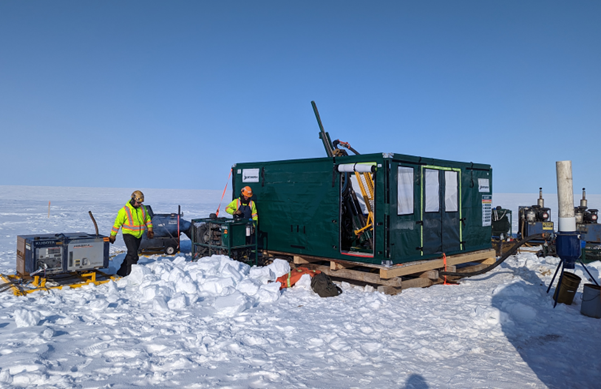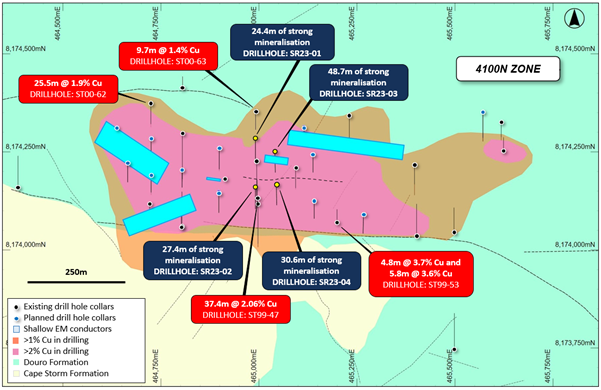helicopter portable RC drill rig "The use of a helicopter portable RC drill rig has allowed the earliest ever start to a drill program at Storm, and our partners are well positioned to complete the work required to define maiden copper resources at the 4100N, 2750N and 2200N Zones this year. The detailed MLEM program, also underway and already yielding actionable results, is proving to be valuable in refining targets for the resource drilling as well as defining new targets for additional discovery."
 Figure 1: RC drilling underway 4100N Zone, Storm Copper Project. Every drill hole completed to date in the 2023 drill program has successfully intersected copper sulfide mineralization.
Figure 1: RC drilling underway 4100N Zone, Storm Copper Project. Every drill hole completed to date in the 2023 drill program has successfully intersected copper sulfide mineralization.
IMMEDIATE SUCCESS HIGHLIGHTS RESOURCE POTENTIAL
The first four completed drill holes at the 4100N Zone have begun to confirm the continuity of the copper zones and highlight the resource potential of the near-surface mineralization. All drill holes have intersected thick intervals of visual sulfides, which have been confirmed to contain copper based on portable XRF analysis.
Over 3,000m of historical drilling at the 4100N Zone has identified widespread copper sulfide mineralization over an area of approximately 32 hectares. This mineralization is a focus for resource drilling due to its shallow nature and potential to provide a significant resource base as the basis for an initial low-cost, open-pit mining operation.
DRILL HOLE DETAILS
Drill holes SR23-01, SR23-02, SR23-03 and SR23-04 have intersected thick intervals of copper sulfide mineralization, hosted within dolomite of the Allen Bay Formation.
The mineralization encountered within the drilling to date comprises zones of strong sulfides hosted within a broad mineralized package of what is interpreted to be mostly vein and fracture-style mineralization. The mineralized horizons are interpreted to be relatively flat-lying and hosted within a porous, laterally extensive carbonate layer.
The dominant copper sulfide mineral observed within the drill holes to date is chalcocite, with minor bornite and chalcopyrite on the margins of the mineralized intervals and within veins. Minor native copper and copper oxides (mostly malachite and cuprite) are also present.
Chalcocite is an important ore mineral due to its high copper content (79.8% copper) and outstanding metallurgical properties.
The Allen Bay host unit is present throughout the Storm Project area and is composed of massive to thinly bedded dolomicrites.
| Hole ID | Prospect | Easting | Northing | Depth (m) | Azi | Inclination | Type |
| SR23-01 | 4100N | 464991 | 8174285 | 137.2 | 180 | -65 | RC |
| SR23-02 | 4100N | 464990 | 8174157 | 140.2 | 180 | -59 | RC |
| SR23-03 | 4100N | 465041 | 8174251 | 151 | 178 | -65 | RC |
| SR23-04 | 4100N | 465045 | 8174166 | 152.4 | 179 | -69 | RC |
Table 1: 2023 program drill hole details. Note - depth in metres has been converted from measurements in feet and is rounded.
Intersections are expressed as downhole widths and are interpreted to be close to true widths. Visual estimates of sulfide type, quantity and habit should not be considered a substitute for laboratory assays. Portable XRF analysis has been used to confirm the nature of the sulfide intercepts. Laboratory assays are required to determine the widths and grade of mineralization as reported in preliminary geological logging.
 Figure 2: Plan view of the 4100N Zone showing interpreted copper mineralization footprint (defined by drilling), shallow EM anomalies and drilling, overlaying regional geology. Stated diamond drill hole intersections (red text boxes) are all core length, and true width is expected to be 60% to 95% of core length. Stated RC dill hole intersections (blue text boxes) are close to true widths.
Figure 2: Plan view of the 4100N Zone showing interpreted copper mineralization footprint (defined by drilling), shallow EM anomalies and drilling, overlaying regional geology. Stated diamond drill hole intersections (red text boxes) are all core length, and true width is expected to be 60% to 95% of core length. Stated RC dill hole intersections (blue text boxes) are close to true widths.